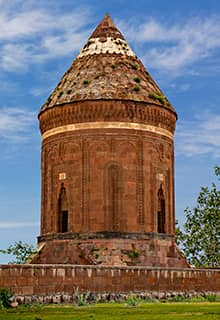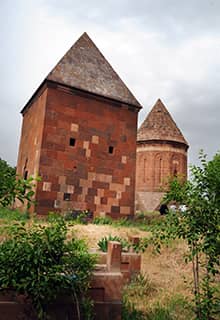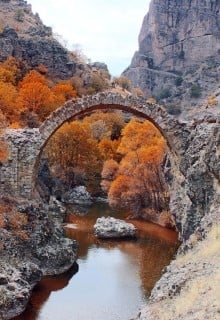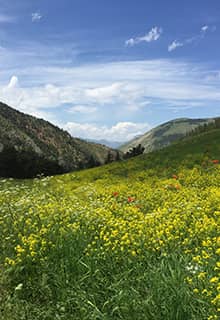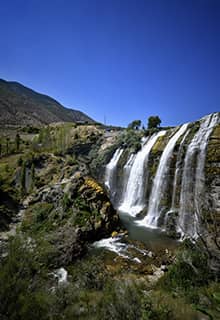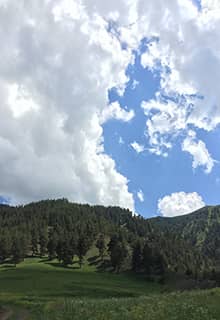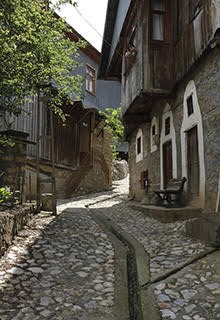

cittaslow cities Eastern
Türkiye
AHLAT/UZUNDERE/ARAPGİR/KEMALİYE
Ahlat
Ahlat, a historical city in the district of Bitlis, northwest of Lake Van, welcomes visitors with an arresting sight of glorious tombstones dating back to the Seljuk period.
Thanks to its geographical location, Ahlat has been a bridge between Eastern and Western civilizations throughout history. Ahlat played a very important role in the migration of Turks from Central Asia to Anatolia.
Throughout history, Ahlat’s significance has been established by its location on the roads from Asia to Anatolia, its warm climate for the standards of the Eastern Anatolian region, its fertile lands, the abundance of local building material suitable for construction, and its water resources.
Just west of Ahlat is an polygonal 13th-century tomb, Usta Şağirt Kümbeti (Ulu Kümbeti), 300 m off the highway. It's the largest Seljuk tomb in the area.
Further along the highway, on the left, is a museum and behind it the vast Selçuk Mezarlığı (Seljuk Cemetery), with stele-like headstones of lichen-covered grey or red volcanic tuff with intricate web patterns and bands of Kufic lettering.
Over the centuries, earthquakes, wind, and water have set the stones at all angles, a striking sight with spectacular Mount Nemrut as a backdrop. Most rocks have a crow standing sentinel, and tortoises patrol the ruins.
On the northeastern side of the graveyard is the unusual Bayındır Kümbeti ve Camii (Bayındır Tomb and Mosque) which dates back to 1477. It has a colonnaded porch and a mihrab, a niche indicating the direction of Mecca.
Other sites include the Çifte Kümbet (Twin Tombs), about 2 km from the old museum towards the town center, and the Ahlat Sahil Kalesi (Ahlat Lakeside Fortress), south of the Çifte Kümbet, which was built during the reign of Süleyman the Magnificent.
Uzundere
Uzundere, a town and district of Erzurum Province, is located on the borders of the Black Sea region and the region of Eastern Anatolia. It is a quiet and peaceful town, rich in history, and abundant in natural beauty.
Many different civilizations have left their traces in this part of the world.
Interestingly, the region has the characteristics of the Mediterranean climate: the summer is quite hot and humid, and the winter is cold and rainy. Many different types of fruit grow in the district, and even in winter, parts of the region remain green. The locals’ main livelihood is agriculture and animal husbandry.
Tortum Waterfall, Türkiye's tallest waterfall, is located 17 kilometers from the center of Uzundere. The waterfall is fed by the surplus water of Tortum Lake that is situated 1,000 meters above sea level. There is a recreation area around the waterfall with an observation platform, and a staircase that leads underneath the waterfall.
Another local attraction is the Oshki Monastery. The monastery is one of the most magnificent examples of the cultural and architectural heritage of the Tortum Valley and the district of Uzundere. The structure was built by Georgians in the tenth century and was dedicated to St. John the Baptist. The monastery was an important center of Georgian literature and is famous for its 11th-century manuscripts.
Arapgir
In 2021, the Arapgir district was designated as a Cittaslow (Slow City). It is also the first district of Malatya to be granted ‘The Cittaslow Status’.
The first settlement in the area is thought to have occurred around 1200 BC. After being the home of various civilisations throughout its history, Arapgir was fully integrated into the Ottoman Empire with the Battle of Chaldiran in 1515.
Arapgir is one of the most significant stops on the Historical Silk Road. Millet Han, which is today used as a boutique hotel, was built in the 19th century and served as a trade centre. The Arapgir Ulu Mosque, a legacy of the 14th century Ilkhanid Period, and the Gümrükçü Osman Pasha Mosque, with its single minaret and single dome, are both rare works from the Ottoman Period.
Arapgir Houses, which bring life to the district, feature the most stunning photographs. Bekir Serim Tan House, Beyler Mansion, Çobanlı Mansion, Hacı Emiroğulları Mansion, and Rasim Kaşkaloğlu Mansion are some of the leading historical mansions in Arapgir. Meydan Bridge and Kale Bridge, both built on Kozluk Stream, add a different elegance to the district’s historical texture.
Arapgir Kozluk Stream Canyon is a popular destination for photographers who want to hike and camp.
One of the most famous delicacies of Arapgir is the tandır (tandoori) kebab, which is cooked slowly in special oak wood tandooris. One of the features of Arapgir that distinguishes the district is the 'Köhnü' grape for table and wine, which is known to be unique to the region and does not grow anywhere else in the world. ‘Arapgir Mor Reyhanı (Purple Basil)’ like the Köhnü grape, is one of the flavours with geographical indication registration. You can taste these various flavours during your visit to Arapgir and you can even take some home with you to remember your trip.
Kemaliye
Kemaliye, in Eastern Anatolia, is renowned for its historical significance, stunning natural landscapes, and the inviting warmth of its people. Here, visitors find an escape from modern hustle, taking a deep dive into an authentic, serene environment.
The village was historically a crucial stop on the Silk Road, facilitating cultural and economic exchanges between the East and West. This rich past is reflected in its architecture, especially in the Ottoman-era Kemaliye Houses. These stone buildings feature intricate wooden balconies and carved door knobs, showcasing the village's long-standing craftsmanship. A stroll through Kemaliye's alleys offers a journey back in time, surrounded by these well-preserved structures that also highlight the village’s skilled craftsmanship through ornately carved wooden door knobs and locally sourced stone work.
Kemaliye's stunning geography includes the majestic Euphrates River, surrounded by mountains and lush forests. A notable natural attraction is the Karanlık Canyon, an awe-inspiring gorge with towering cliffs and narrow passages that filter sunlight, creating mystical shadows. The canyon, along with local streams and the Karasu Waterfall, offers visitors spectacular nature trails and peaceful spots for relaxation.
Kemaliye also serves as a haven for wildlife, supporting a diverse ecosystem where one might spot rare birds or the elusive Anatolian leopard. Conservation is a priority, preserving the natural beauty for future generations.
Cultural vibrancy is alive in Kemaliye through the preservation of Seke traditions. Residents maintain their heritage through traditional clothing, folk dances, and handicrafts, enriching visitors' experiences with authentic cultural insights.
Culinary delights are integral to the Kemaliye experience, with local dishes like "testi kebabı" and "kuymak" offering a taste of traditional Turkish cuisine. The hospitality of Kemaliye’s residents ensures a welcoming and memorable visit.
Kemaliye, with its combination of natural beauty, rich history, and cultural depth, promises a unique and enchanting experience for all who visit. Whether you're seeking adventure, cultural immersion, or a tranquil retreat, Kemaliye captures the heart with its timeless charm and scenic splendor.
Kemaliye is also a member of the UN Tourism’s “Best Tourism Villages Upgrade Program”.

